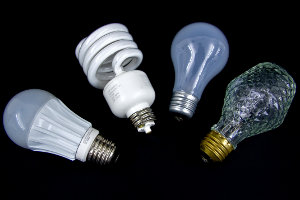[jwplayer config=”QUEST Audio Player” skin=”http://ww2.kqed.org/quest/wp-content/themes/quest/glow.zip” file=”http://www.kqed.org/.stream/anon/radio/quest/2011/01/2011-01-24-quest.mp3″ ]
Listen to the QUEST radio story How CFLs Got Their Bad Rap.
“If you go into a home today in the US, fluorescents are the exception,” Siminovich says. “We should have transformed this marketplace by now, but by and large it’s been a dismal failure.”
So what happened? According to Siminovich, there were two big misconceptions and one big mistake.
Misperception number one: The light from CFLs is ugly and unflattering.
To Siminovich, this is both the oldest complaint in the book and the easiest to resolve. He takes me over to a wall of wooden cubbies, each about a foot square. Installed in each is a different type of bulb, including several CFLs.
Under the first CFL, my hand looks pale and sickly. I tell Siminovich I look like a corpse. “Yep,” he says, “and this is how bad it is in some people’s homes.”
Those people simply bought the wrong type of compact florescent. CFLs with high K (Kelvin) numbers –around 5000 — give off a cool, blue-green light. But get one with a lower K number, say 3000, and it’s as warm as any incandescent.
Misperception number two: CFLs aren’t well- made
Siminovich says initially, that was true.
Many bulbs, he says were touted as lasting for five years. “So when you stick this in and then it dies six months later. That leaves a terrible experience in your mind.”
Which brings us to what Siminovich says was the big mistake. It has to do with the reason CFLs became so ubiquitous, in the first place.
For an explanation, I called Max Neubauer, research associate with the American Council on Energy Efficiency, a nonprofit advocacy group in Washington DC. The ACEE evaluates and compares various states’ efficiency programs. (California consistently ranks at the top of the list.)
He says from a state government standpoint, CFLs are pretty much efficiency 101.
“If you look at any state that’s invested in energy efficiency, chances are they’ve invested in some sort of lighting program, including buying a lot of CFLs.”
At both the state and federal level, government agencies have spent billions of dollars subsidizing CFLs. Here in California alone, energy utilities, like PG&E, are spending over 500 million ratepayer dollars, over the course of seven years, on CFLs.
And when you buy tens of millions of light bulbs at a time, you probably want to get the cheapest ones you can find, says Siminovich.
“So what did the poor lamp manufacturers do? They compromised some of the color, some of the quality, so we ended up with a lot of compact fluorescent lamps that don’t satisfy people’s preferences.”
In short: state and federal agencies bought millions of inexpensive and low-quality CFL bulbs. Many of the bulbs burned out early or made people look corpse-like. That’s how CFLs got their bad rap.
To be fair, the bulbs have made a difference in energy use, although their exact contribution is hard to quantify. The ACEE’s Max Neubauer believes CFLs aren’t a bad first step for states to take, especially if they follow it up with more sophisticated efficiency programs.
But to Siminovich, those early investments in CFLs were a missed opportunity to have achieved greater savings, earlier on.
“A more expensive lamp — $5, $4 — a lamp that produces great color, lasts five years, is dimmable,” he says, “we could have transformed the marketplace.”
Well, it took a while, but today that’s what’s happening.
At the Home Depot in Daly City, there are still some 100-watt bulbs on the shelves, but when they sell out, it’s over.
Assistant Manager Brian Thomas says when customers ask about the phase-out, he has a very simple response. “We show them our display.”
The display is a table with about a dozen lit bulbs of different types, including traditional incandescents, and CFLs. Thomas points to the CFL.
“Look at this and you can’t tell me that’s less bright than a normal incandescent, right? And it’s dimmable. I mean it’s not only better for the environment, but it’s going to save them money down the long run.
38.551087 -121.716295
 The evolution of the light bulb.
The evolution of the light bulb.